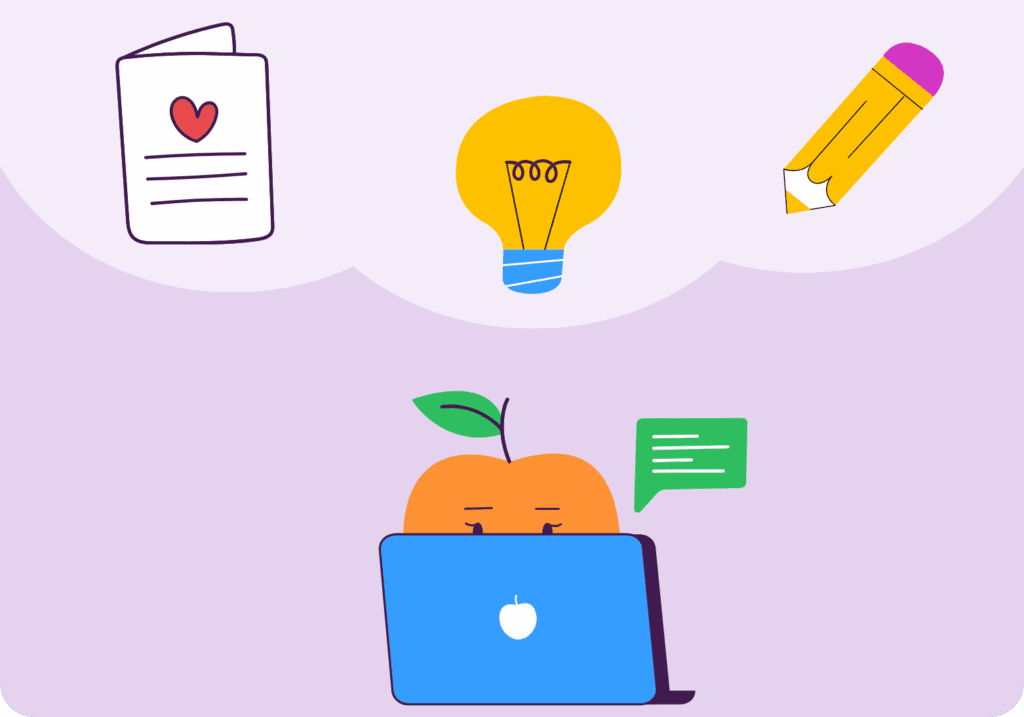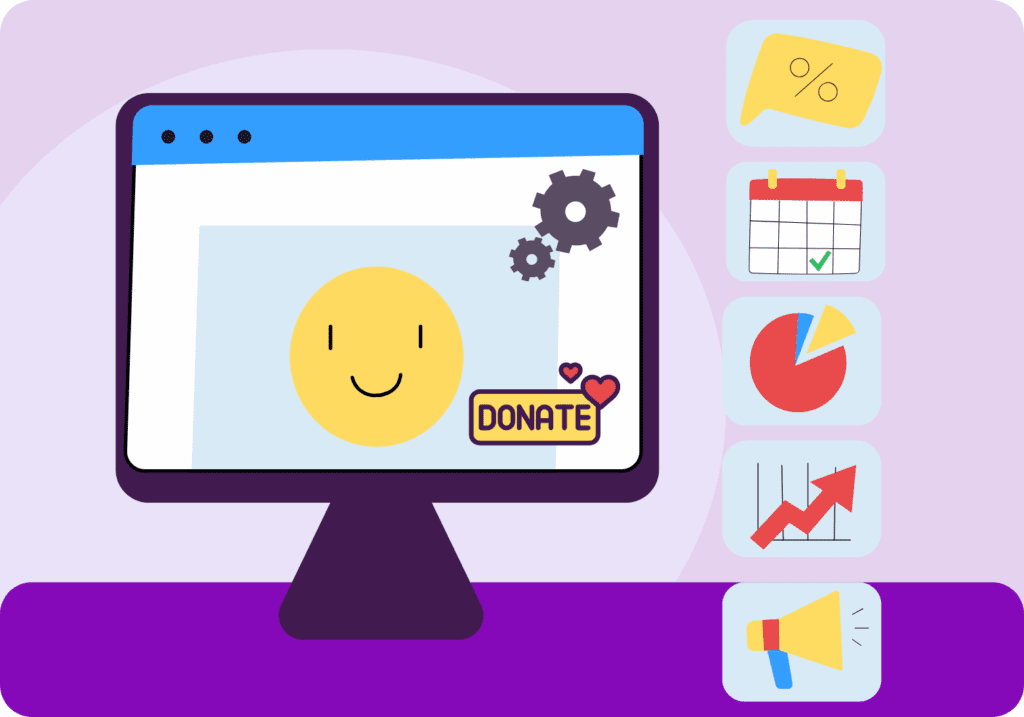Storytelling is a vital tool any organization can use in a variety of ways to improve fundraising and communications. Whether you’re creating immersive website experiences or building relationships on social media.
You might think this is a simple concept, but telling your nonprofit’s story – the right way – is more complex than you may think.
What is Nonprofit Storytelling?
Nonprofit storytelling, at its core, is the stories your nonprofit shares to promote its mission and initiatives. But it’s more than just laying out the facts. Effective storytelling is filled with emotions and details – this is what brings the story to life – giving the reader something to connect to, something that is memorable.
Pulled from interviews and real-life experiences of volunteers, supporters, donors and recipients; the narrative your nonprofit shares should build an emotional connection. Emphasizing the impact you make and stressing the importance of continuing your work.
Why Does Storytelling Matter for Nonprofits?
Your nonprofit’s goal is to make a difference for your community or area of interest. Your mission is your purpose and storytelling is how you get others on board; how you encourage someone to become a supporter.
Storytelling is done across all channels of your nonprofit’s communication. From simple headers on your website and verbiage used in emails to the more complex content you share, like articles on social media and fundraising events you execute – storytelling is prevalent.
Connects Your Mission to Emotions
Have you ever seen a commercial or short video with emotional music in the background and powerful visuals? Did it tug on your heartstrings a little bit? You probably thought about it for the rest of the day. Perhaps you even donated or signed up to support their cause. Whether it was an ASPCA commercial asking you to help animals or a video about a child’s fight with cancer, you felt empathy.
Empathy is feeling with, as opposed to feeling for, which is sympathy. Empathy is the point the where the story is resonating on a deep level. Someone can relate to that story through life experience, emotional experience or something else. No matter what that point of relatability is, it makes the story memorable.
If you’re able to cultivate empathy through your storytelling, your message will have that much more impact. Our emotions drive our decision making, so connecting your mission’s story to an emotion – joy, sadness, fear, gratitude, guilt, pride, anger, interest, inspiration – you can increase someone’s investment in your cause.
Read more: Mission to Messaging: The 2025 Nonprofit Branding Playbook
Creates Stronger Relationships with Supporters
Think of nonprofit storytelling as making a new friend or dating someone new. With each new story or experience you share, you reveal more about you, more about your passions and what makes you tick. The same thing goes for your nonprofit.
Every time your nonprofit shares an impact story, you’re sharing about your nonprofit’s purpose and what you do to make a difference. These stories build a relationship with your supporters. The more they hear about the work you do, the stronger that relationship becomes.
With a strong connection, supporters can advocate on your behalf and increase your reach. With an extensive network, imagine the impact your nonprofit organization can make!
Boosts Your Organization’s Credibility
Impact stories should be told from the perspective of your main character – the volunteer, donor, recipient or a supporter. This is what makes your cause credible.
Real people are sharing their experience from your efforts. After all, don’t you look up reviews from real people before buying something? The stories you share deliver a similar result – evidence that your organization is doing what you say.
Consider this storytelling technique: rather than “our nonprofit’s fundraising efforts benefitted Sarah and her family”, tell Sarah’s story with her experience. “Sarah and her family found housing and hope through our program.” Include direct quotes whenever possible. For example: Sarah shared “I can’t express how much gratitude I have for Habitat for Humanity. They’ve transformed my family’s life after the hurricane devastated our neighborhood.”
Inspires Others to Take Actions
No matter the story your nonprofit is telling, it should inspire others to act. Think of storytelling is a tactic for achieving a goal.
With the emotional impact intertwined throughout your narrative, you’re guiding your audience’s actions. This could be any action, like signing up to become a volunteer or donating to a fundraising campaign.
Effective storytelling will easily inspire your supporters and result in success of any of your marketing campaign initiatives.
Elements of Effective Nonprofit Storytelling
To be successful in your nonprofit’s storytelling, you need to have the proper story structure. Utilizing these elements in all of your impact stories will convey your message, inspire action and expand your nonprofit’s reach.
The Story’s Hero
Every good story has a protagonist – the hero of the tale. This will be the main character.
For the purpose of nonprofit storytelling this person can be:
- A volunteer
- A donor
- The beneficiary of your fundraising campaigns
- The recipient of your physical impact
- A staff member
Keep in mind the story could be written by the main character (first person) or by someone else (third person), but the message will always be focused solely on the hero’s journey and the impact they made/received.
A Clear Conflict or Problem
As every compelling story has, your main character must have a conflict or problem that must be solved.
When it comes to storytelling for nonprofits, the conflict can be something that is happening directly to the hero – like food insecurity, homelessness due to a natural disaster or health struggles due to cancer or illness.
The conflict can also happen to someone/something the hero cares deeply about. This could be situations where your hero is a volunteer or donor: people in positions of support who share their experience seeing the impact your nonprofit has made. A great example is animal welfare, the animals can’t speak for themselves about the problem of shelter or needing food, but volunteers speak on their behalf.
The Journey to Success
As the hero of your story encounters the conflict, great storytelling focuses on the journey. This is the how of your tale.
The journey of your nonprofit’s story should answer these questions:
- How did we succeed?
- How was your nonprofit involved?
- How did the help of donors, volunteers and supporters make it happen?
These answers will not only be the meat of your story, but also help motivate others. The impact made by your organization is done through the help of supporters and the reader of this story will be inspired to join.
Read more: How to Promote a Fundraiser: Tips to Boost Awareness and Donations
Your Nonprofit as the Guide
The guide of your nonprofit’s story will always be your nonprofit. Sometimes acting as the narrator, sharing your hero’s story; whereas other times your nonprofit will the the guiding light, support or tool that the hero will utilize to reach success.
Think of your nonprofit as the Yoda to Luke Skywalker’s story in Star Wars or Mufasa to Simba in the Lion King. If you’re into sports, your nonprofit is the coach and the team is the story’s hero.
Your nonprofit will provide things like the following to aid your protagonist:
- Opportunities: scholarships, internships, platforms to share their story
- Financial Support: grants, rent assistance, subsidized services
- Connections: support groups, training and workshops, networking or mentoring
- Events and Campaigns: fundraisers, donation drives, advocacy or awareness
Emotion-Driven Details and Visuals
The most important part of storytelling for nonprofits will be your emotional pacing. As you share about your main character, the struggles they have and how they found success with your nonprofit – emotion should be at the forefront.
To truly connect to your protagonist, the reader needs to feel for them and want to advocate for them. Part of your storytelling tools will be in the visual content you pair with your narrative. Photos and video clips can make the big difference between an effective story and a forgettable story.
We’ll share more examples of great nonprofit storytelling below, but here’s a fantastic case where video storytelling helped convey emotion, the hero’s success and the impact The Princess Margaret Ride to Conquer Cancer makes.
Authenticity
Everyone can appreciate a fictional narrative, but when it comes to nonprofit storytelling, this is not the place.
Any time your nonprofit shares the experience of those impacted by your work – it must be true and factual. This not only reinforces the trustworthiness of your organization, but the mission you’re hoping to achieve. Avoid over-exaggerating or putting on a facade when storytelling.
By combining your authenticity with emotion-driven details and visuals, your storytelling will be much more effective. Ultimately, you’ll raise more, widen your nonprofit’s reach and encourage others to join.
Takeaways and Call-to-Action
Sharing your stories is just the first step in making your mark on your mission. A successful nonprofit story will always call the reader to take another step. You’ve captured their attention and hopefully their hearts, now you make your ask.
The call-to-action (CTA) you include in your nonprofit story will do one of the following:
- Donate Now: ask for monetary gifts to reach a fundraising goal
- Share the Story: ask to repost or share the article to raise awareness
- Volunteer: be a part of our efforts and give your time/services
- Subscribe: stay in the know and become a regular supporter of the nonprofit
These CTAs could be a part of your email marketing campaigns, social media posts, impact reports, direct mail letters or even shared live during an event or meeting.
Read more: Why Your Nonprofit Email List Isn’t Working (and How to Fix It)
Nonprofit Storytelling Examples
Now that you have all the elements needed to successfully share a story, check out these standout examples of nonprofit storytelling.
charity : water
In this “story from the field” discover how a teacher, Netra Bahadur Pulami, and the nonprofit, charity : water, changed the lives of students and families in rural Nepal.
This article is full of emotion, compelling visuals and truly tells the story of bringing clean water to make a major impact. Here’s a quote we loved, but check out the story yourself!
“As teachers like Netra began to emphasize the importance of health and hygiene for students, they started having more students to teach. Healthier kids meant fuller classrooms. “When I was little, there was no such thing as dreaming to be an engineer, teacher, or pilot.” Netra shared. “Because the environment didn’t nurture such kinds of ambition.””
World Wildlife Fund

In this article there is a a sense of urgency to the reader around restoring kelp forests. Our main character, Todd, and the nonprofit, World Wildlife Fund, share about Todd’s experience growing up in Maine and the abundance of seaweed. Now, with the kelp forests declining, he and WWF are taking action to combat this.
With the clear story structure and impactful facts about kelp and seaweed, the WWF delivers a compelling story to call the reader to support the science, take action and support conservation.
Doctors Without Borders

Sharing the story of multiple individuals in one piece really helps deliver your message. In this Doctors Without Borders blog, Faces of Resilience, you can learn about the experiences of Fatimah, Karimeh, Ovileya and Sakineh, refugees now living in greece.
With powerful imagery of each woman and direct quotes, you can really feel connected to their stories. The nonprofit, Doctors Without Borders, just sets the stage for them, allowing their experience to be heard.
Wrapping Up: Storytelling Techniques & Tips
Define the Goal of Your Story
When writing your story, think about what you want to achieve. Are you trying to raise money? Do you want more people to hear about your cause? Are you wanting to expand your email list or social media presence?
When you define your goal before the story is written, you can guide the narrative to that CTA. It might be helpful to have this goal in mind before you interview anyone you might quote. This will allow you to tell a story strategically and purposefully.
Make it Human
We’ve said it before, but we wanted to really emphasize the importance of humanity in nonprofit storytelling. These are real people, real experiences and real powerful results.
Clearly Structure the Story
Storytelling structure is crucial to delivering your message properly. Clearly set up your hero and their challenges, then introduce your nonprofit as the guide, celebrate the journey to success and prompt the reader to take a next step. Fill in the rest with compelling visuals and quotes; you’re sure to have an engaging and memorable nonprofit story.
Utilize Direct Quotes
Authenticity is important for your nonprofit when sharing a story, so direct quotes are a must! The real words from people who support or are positively impacted by your nonprofit are more powerful than anything. If you can, provide video testimonials in your articles so readers can see the person sharing their experience.
Support Your Story with Visuals
Visuals are arguably more memorable and influential when it comes to storytelling. They allow the reader to see people and places that have benefited from your nonprofit’s work, rather than just imagining it. Take pictures at volunteer sites, fundraising events and of the individuals you interview. But be sure to gain permission from anyone in your photos or videos!
Make it Easy to Share
At the end of the day your nonprofit’s story is one of many that exist online. Standing out is hard to do, but can be simple if you make a couple adjustments. To reach a wider audience, make your stories easy to share.
Integrate your blogs to your social media accounts and provide one-click links for readers to post on their accounts. Don’t forget to include them in your email campaigns, newsletters, annual reports and event communications.
Read more: The 10-Step Guide to Mastering Facebook for Your Nonprofit (In Just a Few Hours a Week)
Overall, nonprofit storytelling is just a way to share what your nonprofit does. Think about the next story you want to tell. Will it be your founding story? Your mission and vision story? Your most recent impact story? The opportunities are endless.
Now go forth and share!










